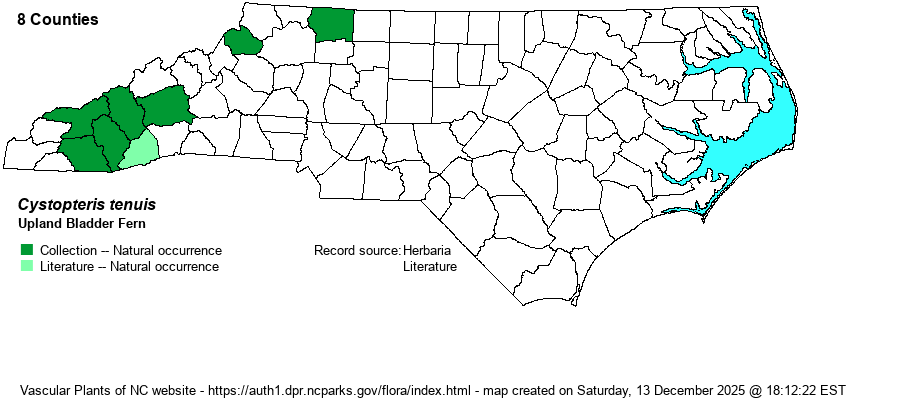| Author | (Michaux) Desvaux | |
| Distribution | Essentially limited to the Mountains, though the specifics of the range are not well understood owing to difficulty of identification of herbarium specimens. There may be misidentified plants of C. protrusa in the current map. For example, the NCNHP database lists it only from Haywood, Transylvania, and Watauga counties. A specimen from Surry County is presumably from the Sauratown Mountains in the western Piedmont.
This is a Northern species, ranging from eastern Canada south to NJ, PA, and IA, and southward mainly in the Appalachians and Ozarks to northern GA and AR. | |
| Abundance | Rare and poorly known, as most biologists probably are not familiar with it and likely would have overlooked it as C. protrusa. Even if overlooked, it likely is a scarce species in NC, as the state is near the southern edge of the range. This is a Significantly Rare species. | |
| Habitat | "Moist outcrops and cliffs of metamorphic and sedimentary rocks, occasionally in moist soils near rock outcrops or moist soil banks" (Weakley 2018). | |
| Phenology | Probably fruits from April to June. | |
| Identification | This species is extremely similar to both C. protrusa and C. fragilis, all three occurring in the mountains of the state. This species has the ovate leaf blade of the quite common C. protrusa, with the bipinnate-pinnatifid shape. Weakley (2018) says that this species has leaves thicker in texture than the thin green leaves of C. protrusa (and C. fragilis); "basal pinnules slightly stalked or merely cuneate to the base; petiole dark brown; lowermost pinnules of each pinna slightly lobed; [often on rocks, less commonly on forest floor]" (Weakley 2018) for this species, versus "basal pinnules conspicuously stalked; petiole green to tan, darkened at base; lowermost pinnules of each pinna deeply cut; [typically on forest floor, less commonly on rocks]" (Weakley 2018) for C. protrusa. In general appearance, the pinnae look more densely packed with pinnules than in C. protrusa, owing to the stalked pinnules of that species carrying them off the "rachis" of the pinnae; plus the pinnules are barely lobed and thus more oval than the more deep sinuses in pinnules of C. protrusa. | |
| Taxonomic Comments | In most references, this species is simply included within C. protrusa or within C. fragilis. Some references named it as C. fragilis var. mackayi.
| |
| Other Common Name(s) | Mackay's Bladder Fern, Mackay's Fragile Fern, Upland Brittle-fern, Upland Brittle Bladder Fern | |
| State Rank | S1 [S1S2] | |
| Global Rank | G5 | |
| State Status | SR-P | |
| US Status | | |
| USACE-agcp | | |
| USACE-emp | | |

